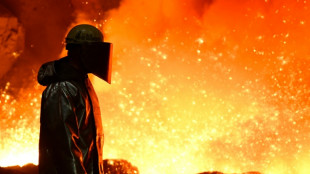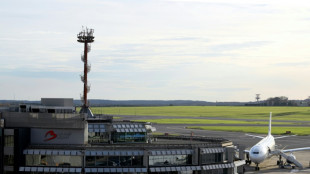
-
 Scandic Trust Group strengthens sales network with First Idea Consultant
Scandic Trust Group strengthens sales network with First Idea Consultant
-
Probe into Thales defence group looking at Indonesian contract

-
 US to cancel flights as longest govt shutdown drags on
US to cancel flights as longest govt shutdown drags on
-
Home in Nigeria, ex-refugees find themselves in a war zone

-
 Doncic's Lakers hold off Wembanyama's Spurs, Blazers silence Thunder
Doncic's Lakers hold off Wembanyama's Spurs, Blazers silence Thunder
-
For Turkey's LGBTQ community, draft law sparks existential alarm

-
 Musk's $1 trillion pay package to face Tesla shareholder vote
Musk's $1 trillion pay package to face Tesla shareholder vote
-
Tonga rugby league star out of intensive care after seizure

-
 Argentine ex-president Kirchner goes on trial in new corruption case
Argentine ex-president Kirchner goes on trial in new corruption case
-
Dams, housing, pensions: Franco disinformation flourishes online

-
 Endo returns as Japan look to build on Brazil win
Endo returns as Japan look to build on Brazil win
-
Franco captivates young Spaniards 50 years after death

-
 German steel industry girds for uncertain future
German steel industry girds for uncertain future
-
IPL champions Bengaluru could be sold for 'as much as $2 billion'

-
 Budget impasse threatens Belgium's ruling coalition
Budget impasse threatens Belgium's ruling coalition
-
New Zealand ex-top cop admits to having material showing child abuse, bestiality

-
 BoE set for finely balanced pre-budget rate call
BoE set for finely balanced pre-budget rate call
-
Australian kingpin obtains shorter sentence over drug charge

-
 Weatherald's unenviable Ashes task: fill giant hole at top left by Warner
Weatherald's unenviable Ashes task: fill giant hole at top left by Warner
-
Ovechkin first to score 900 NHL goals as Capitals beat Blues

-
 On Mexico City's streets, vendors fight to make it to World Cup
On Mexico City's streets, vendors fight to make it to World Cup
-
Asian markets bounce from selloff as US jobs beat forecasts

-
 Philippine death toll tops 140 as typhoon heads towards Vietnam
Philippine death toll tops 140 as typhoon heads towards Vietnam
-
Kyrgios targets 'miracle' Australian Open return after knee improves

-
 'AI president': Trump deepfakes glorify himself, trash rivals
'AI president': Trump deepfakes glorify himself, trash rivals
-
Belgium probes drone sightings after flights halted overnight

-
 Five things to know about 'forest COP' host city Belem
Five things to know about 'forest COP' host city Belem
-
World leaders to rally climate fight ahead of Amazon summit

-
 Engine fell off US cargo plane before deadly crash: officials
Engine fell off US cargo plane before deadly crash: officials
-
Mexican leader calls for tougher sexual harassment laws after attack

-
 Meghan Markle set for big screen return: reports
Meghan Markle set for big screen return: reports
-
Japan deploys troops after wave of deadly bear attacks

-
 Diageo PLC Issues Fiscal 26 Q1 Trading Statement
Diageo PLC Issues Fiscal 26 Q1 Trading Statement
-
NV Gold Announces Closing of First Tranche of Private Placement

-
 FIFA announce new peace prize to be awarded at World Cup draw in Washington
FIFA announce new peace prize to be awarded at World Cup draw in Washington
-
Australia's Cummins hints at return for second Ashes Test

-
 Boeing settles with one plaintiff in 737 MAX crash trial
Boeing settles with one plaintiff in 737 MAX crash trial
-
Man City win as Inter stay perfect, Barca held in Champions League

-
 French superstar DJ Snake wants new album to 'build bridges'
French superstar DJ Snake wants new album to 'build bridges'
-
Barca rescue draw at Club Brugge in six-goal thriller

-
 Foden hits top form as Man City thrash Dortmund
Foden hits top form as Man City thrash Dortmund
-
NBA officials brief Congress committee over gambling probe

-
 Inter beat Kairat Almaty to maintain Champions League perfection
Inter beat Kairat Almaty to maintain Champions League perfection
-
Newcastle sink Bilbao to extend Champions League winning run

-
 Wall Street stocks rebound after positive jobs data
Wall Street stocks rebound after positive jobs data
-
LPGA, European tour partner with Saudis for new Vegas event

-
 Eyes turn to space to feed power-hungry data centers
Eyes turn to space to feed power-hungry data centers
-
Jazz lose Kessler for season with shoulder injury

-
 League scoring leader Messi among MLS Best XI squad
League scoring leader Messi among MLS Best XI squad
-
MLS bans Suarez for Miami's winner-take-all playoff match


Skimming the Sun, probe sheds light on space weather threats
Eruptions of plasma piling atop one another, solar wind streaming out in exquisite detail -- the closest-ever images of our Sun are a gold mine for scientists.
Captured by the Parker Solar Probe during its closest approach to our star starting on December 24, 2024, the images were recently released by NASA and are expected to deepen our understanding of space weather and help guard against solar threats to Earth.
- A historic achievement –
"We have been waiting for this moment since the late Fifties," Nour Rawafi, project scientist for the mission at the Johns Hopkins Applied Physics Laboratory, told AFP.
Previous spacecraft have studied the Sun, but from much farther away.
Parker was launched in 2018 and is named after the late physicist Eugene Parker, who in 1958 theorized the existence of the solar wind -- a constant stream of electrically charged particles that fan out through the solar system.
The probe recently entered its final orbit where its closest approach takes it to just 3.8 million miles from the Sun's surface -- a milestone first achieved on Christmas Eve 2024 and repeated twice since on an 88-day cycle.
To put the proximity in perspective: if the distance between Earth and the Sun measured one foot, Parker would be hovering just half an inch away.
Its heat shield was engineered to withstand up to 2,500 degrees Fahrenheit (1,370 degrees Celsius) -- but to the team's delight, it has only experienced around 2,000F (1090C) so far, revealing the limits of theoretical modeling.
Remarkably, the probe's instruments, just a yard (meter) behind the shield, remain at little more than room temperature.
- Staring at the Sun –
The spacecraft carries a single imager, the Wide-Field Imager for Solar Probe (WISPR), which captured data as Parker plunged through the Sun's corona, or outer atmosphere.
Stitched into a seconds-long video, the new images reveal coronal mass ejections (CMEs) -- massive bursts of charged particles that drive space weather -- in high resolution for the first time.
"We had multiple CMEs piling up on top of each other, which is what makes them so special," Rawafi said. "It's really amazing to see that dynamic happening there."
Such eruptions triggered the widespread auroras seen across much of the world last May, as the Sun reached the peak of its 11-year cycle.
Another striking feature is how the solar wind, flowing from the left of the image, traces a structure called the heliospheric current sheet: an invisible boundary where the Sun's magnetic field flips from north to south.
It extends through the solar system in the shape of a twirling skirt and is critical to study, as it governs how solar eruptions propagate and how strongly they can affect Earth.
- Why it matters –
Space weather can have serious consequences, such as overwhelming power grids, disrupting communications, and threatening satellites.
As thousands more satellites enter orbit in the coming years, tracking them and avoiding collisions will become increasingly difficult -- especially during solar disturbances, which can cause spacecraft to drift slightly from their intended orbits.
Rawafi is particularly excited about what lies ahead, as the Sun heads toward the minimum of its cycle, expected in five to six years.
Historically, some of the most extreme space weather events have occurred during this declining phase -- including the infamous Halloween Solar Storms of 2003, which forced astronauts aboard the International Space Station to shelter in a more shielded area.
"Capturing some of these big, huge eruptions...would be a dream," he said.
Parker still has far more fuel than engineers initially expected and could continue operating for decades -- until its solar panels degrade to the point where they can no longer generate enough power to keep the spacecraft properly oriented.
When its mission does finally end, the probe will slowly disintegrate -- becoming, in Rawafi's words, "part of the solar wind itself."
D.Moore--AMWN


